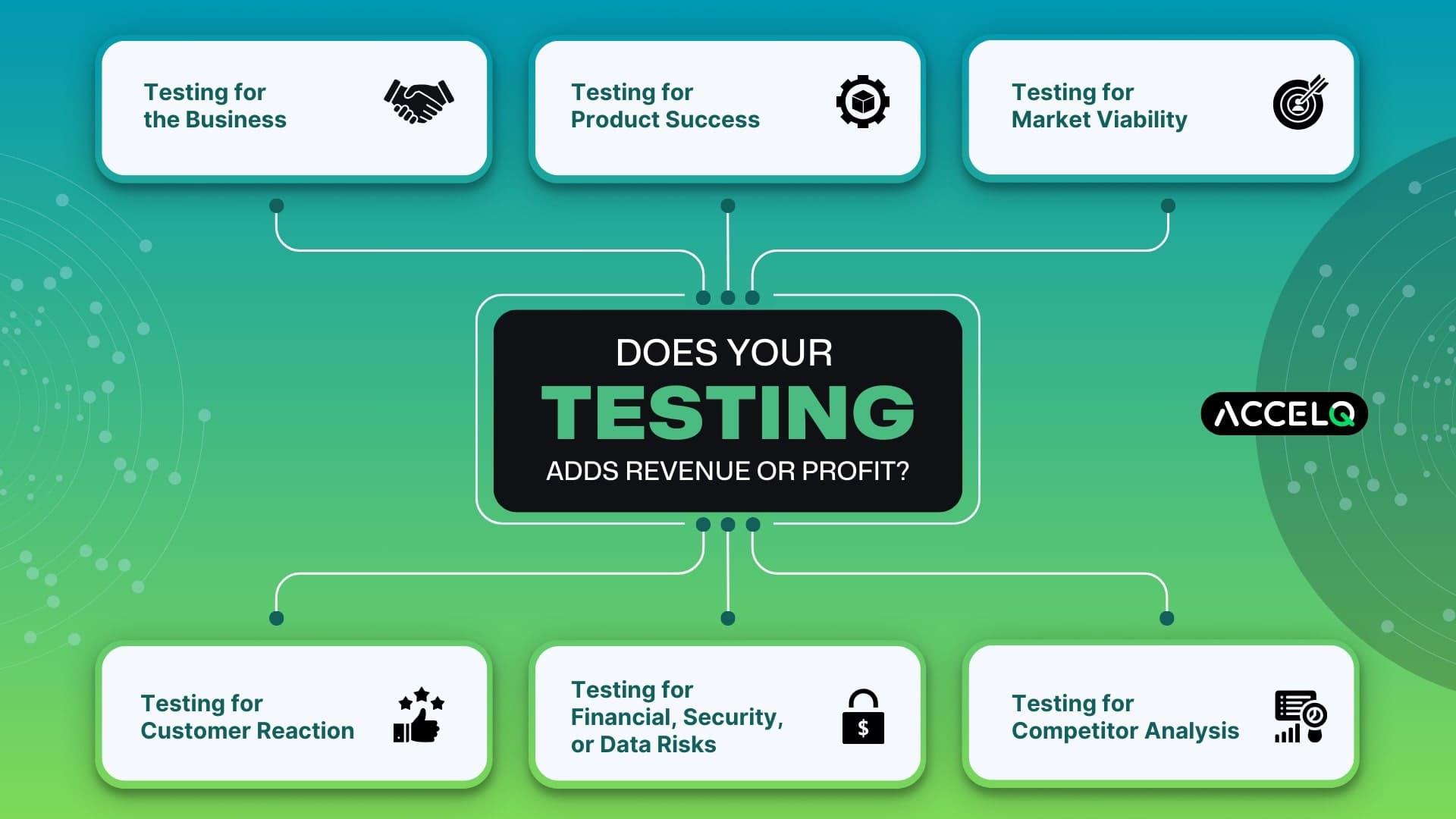Importance Of Business Value of Testing

Picture this: You're in a restaurant, eagerly awaiting your meal. It arrives, looking delicious, but there's something missing – the taste. You take your first bite, and it's bland, leaving you utterly unsatisfied. What secret ingredient could have turned this ordinary meal into a culinary masterpiece? It's salt. Like salt is the invisible flavor enhancer in food, testing holds a similar role in software development. It's mixed into everything that goes out to production, yet it often goes unnoticed, but without it your product can be tasteless.
Does Your Testing Adds Revenue or Profit?
One of the most common notions in the software industry is that it sees testing as a cost center. In the early phases of my career, even as a tester used to believe that testing is all about adding cost for any business. However, as I grew in my career, I started to see the other side of testing which often gets ignored in the general discussions about testing. In reality, testing can be a significant source of revenue and profit. Here's how:
Testing for the Business
Testing isn't just about identifying bugs and running scripts; it's about ensuring your software has a competitive edge in the market. A thoroughly tested product shines at various hidden quality criteria and stands a better chance of gaining customer trust, satisfaction, and loyalty.
Testing for product success
Your product's success depends on multiple factors such as its features, user experience, charisma, support, documentation, etc. Testing helps identify bottlenecks, experience issues, and other critical success factors that can make or break your product's success.
Testing for Market Viability
No company wants to create a bug-free, quality product that does not sell or engage users. Your product needs to be market-ready and should solve issues customers would be willing to pay for or expect the most from the market. Testing ensures that your software is functionally correct and user-friendly, appealing to potential customers and solving the right problems for them.
Testing for customer reaction
Nobody likes to purchase a product and then experience annoyance and frustration when using it. Testing helps you discover and fix issues that might annoy your customers, which can lead to lost sales and a bad reputation in the market.
Testing for potential financial, security or data risks
Often, people see testing as a process of verifying requirements. But, what if certain requirements are not documented at all? Security and data protection are a few such implicit requirements. Data breaches and security lapses can lead to severe financial and reputational damage. Testing helps identify and mitigate these risks.
Testing for competitor analysis
Every product needs to stand out in a competitive market. Effective testing can help you verify marketing claims, features, desired user experiences, and performance levels to help you outshine your competitors.
Pro Tip: While most testers do all the above as part of their daily work, only a small fraction know and practice the art of communicating their testing story to their stakeholders. Communicating your testing story is an unavoidable part of your testing game. Use it to showcase and highlight the business value of software testing.
How to Sell the Business Value of Testing?
Selling the value of testing is a skill similar to selling anything else in the world. Selling is about exchanging value. To find the best price for what you are selling, it’s important to highlight the value of your work. But what are the steps to successfully sell the value of testing within your organization? Here is the three-step selling formula to sell better:
Determine stakeholders
Identify who within and outside your team is affected from testing work. This includes:
- Inside your team: Developers (Dev), Product Owners (PO), Business Analysts (BA), etc.
- Outside your team: Marketing Folks, Management Team, Sales Team, Business Team, etc.
Identify their problems
Once you know your targets, start with understanding their goals and challenges. Proactively initiate one-on-one discussions to discuss their pain points and identify gaps that may put them at risks. Perform Risk Analysis to uncover:
- Product Risks: Risks that could affect the quality of the product.
- Project Risks: Risks that could impact the project’s schedule and budget.
- Operational Risks: Risks that might hinder smooth operational processes.
- Technology Risks: Risks originating from the technology stack being used.
How testing can solve these problems
This is where the magic happens. Present a compelling case for how testing can address your identified issues. This stage needs a lot of practice. Utilize every opportunity and use various mediums, such as:
- Test Strategy: Explain how testing aligns with the overall project strategy. Elaborate on how your testing approach will be based on the contextual project and product factors.
- Blogs / Inner Materials: Most testing material on the web is filled with misinformation and low standard testing folklore. Instead, Share insightful articles and internal documentation to educate stakeholders about testing.
- Case Studies: Showcase success stories from existing projects where testing significantly impacted. Use data to drive your case study.
- Demos: Visual demonstrations of your day to day testing work and how it helps the business.
- Testing Library: Create a repository of resources such as checklists, recordings, workshops, learning sessions, chat forums for doubts, and testing stories to elevate and culminate a culture of good testing knowledge.
Selling Tips from Experience
- Be Consistent: Don’t make testing an occasional topic. Serious professionals regularly express their love and passion for testing.
- Showcase work often: Regularly highlight how testing contributes to the product’s success. Showcase the value and impact of your testing work.
- Organize meaningful events: Create themes, platforms, and events where you and fellow testers can showcase the testing journey in your project and organization.
- Collaborate with other stakeholders: Collaborative efforts often yield the best results. I was never aware of how I could solve a larger problem in my organization until I started proactively initiating conversations with folks outside my software team.
Conclusion
In conclusion, I would like to say that just like salt in food, testing is the invisible ingredient that can transform a bland product into a masterpiece. It's the unsung hero of any software development project, and when done right, it adds flavor to your business. So, remember to communicate your testing story, highlight the product challenges it addresses, provide before-and-after reports, and showcase its impact on your organization. All the best with this journey of finding and showcasing the business value of your testing.
Discover More
 Practical Tips To Writing Clean Code For Test Automation/SDET Engineers
Practical Tips To Writing Clean Code For Test Automation/SDET Engineers
Practical Tips To Writing Clean Code For Test Automation/SDET Engineers
 QCommunity Talks with Isabel Evans-“The notion of quality and the notion of failure”
QCommunity Talks with Isabel Evans-“The notion of quality and the notion of failure”

































